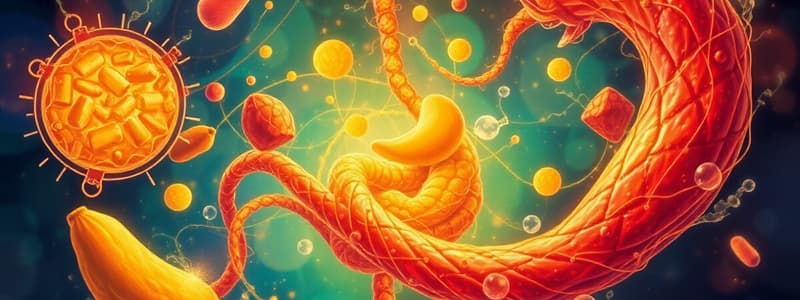Podcast
Questions and Answers
What type of acid is primarily associated with high starch diets?
What type of acid is primarily associated with high starch diets?
- Citric acid
- Propionic acid (correct)
- Butyric acid
- Acetic acid
Which component of rumen gas is typically present in the highest percentage?
Which component of rumen gas is typically present in the highest percentage?
- Hydrogen
- Nitrogen
- Methane
- Carbon Dioxide (correct)
What effect does lignin have on the digestibility of feedstuffs?
What effect does lignin have on the digestibility of feedstuffs?
- Increases nutrient availability
- Has no effect
- Decreases digestibility (correct)
- Increases digestibility
Which factor is NOT part of the animal factors governing microbial digestion of crude fiber?
Which factor is NOT part of the animal factors governing microbial digestion of crude fiber?
What is the impact of pelleting on the digestion of crude fiber?
What is the impact of pelleting on the digestion of crude fiber?
How much methane is typically produced from every 100 g of carbohydrates digested?
How much methane is typically produced from every 100 g of carbohydrates digested?
Which dietary addition is suggested to help lower methane production in ruminants?
Which dietary addition is suggested to help lower methane production in ruminants?
What trace element is essential for microbial processes in ruminants?
What trace element is essential for microbial processes in ruminants?
What are the primary end products of carbohydrate digestion in ruminants?
What are the primary end products of carbohydrate digestion in ruminants?
Which linkage type in starch can be broken by both mammalian and microbial enzymes?
Which linkage type in starch can be broken by both mammalian and microbial enzymes?
Which carbohydrate type is not digested by the mammalian enzyme system?
Which carbohydrate type is not digested by the mammalian enzyme system?
What is the simplest form of carbohydrates known as?
What is the simplest form of carbohydrates known as?
In which part of the digestive system does the primary carbohydrate digestion occur for ruminants?
In which part of the digestive system does the primary carbohydrate digestion occur for ruminants?
Which type of feedstuff is high in cellulose and primarily utilized in ruminant diets?
Which type of feedstuff is high in cellulose and primarily utilized in ruminant diets?
Which of the following substances are major dietary sources of energy for animals?
Which of the following substances are major dietary sources of energy for animals?
What are the primary short-chain fatty acids produced from carbohydrate fermentation in ruminants?
What are the primary short-chain fatty acids produced from carbohydrate fermentation in ruminants?
Flashcards are hidden until you start studying
Study Notes
Carbohydrates
- Chemically, carbohydrates are composed of carbon, hydrogen, and oxygen.
- Carbohydrates are the primary energy source for animals.
- The simplest carbohydrates are monosaccharides, including glucose, fructose, and galactose.
- Disaccharides are formed by the linkage of two monosaccharides, such as sucrose and lactose.
- Polysaccharides are composed of three or more monosaccharides, with starch and cellulose being the most prevalent.
- Starch is composed of glucose molecules linked via alpha linkages, which can be broken down by both mammalian and microbial enzymes.
- Cellulose is composed of glucose molecules linked via beta linkages, which can only be broken down by microbial enzymes.
- Grains are high in starch, while forages are high in cellulose.
- Other carbohydrates, like pectins and hemicellulose, can only be digested by microbes.
Carbohydrate Digestion and Absorption
- In monogastric animals, starch is the primary carbohydrate source.
- Pancreatic amylase, along with other enzymes, digests starch in the small intestine.
- Monosaccharides are readily absorbed into the bloodstream via the small intestine.
- Some monogastrics, like horses, can utilize forage due to their microbial population size and location.
- Horses have the highest utilization efficiency of fibrous compounds among monogastrics, allowing for fibrous feedstuffs to be included in their diets.
- In ruminants, the reticulorumen is the primary site for carbohydrate digestion.
- Dietary carbohydrates are initially subject to microbial digestion in the rumen.
- Sugars, starch, hemicellulose, and cellulose are the primary substrates digested and metabolized by the rumen microbial population.
- The end products of digestion in ruminants are volatile fatty acids (VFAs) and some monosaccharides.
- The primary VFAs are acetic acid, propionic acid, and butyric acid.
- VFAs are absorbed across the rumen or small intestine and metabolized to produce energy-yielding compounds like glucose.
- High starch diets lead to a higher proportion of propionic acid, while higher fiber diets are characterized by a higher proportion of acetic acid.
- Intestinal digestion of carbohydrates is limited in mature ruminants.
Lignin
- Lignin is a polyphenolic polymer associated with fibrous feedstuffs.
- It is indigestible by both microbial and mammalian enzymes.
- Lignin reduces the digestibility and availability of nutrients in feedstuffs.
- Lignin content increases as a plant matures.
Gas Production
- Methane (CH4) is a primary component of natural gas and a greenhouse gas.
- Rumen gas typically consists of 40% CO2, 30-40% methane, 5% H2, and small proportions of O2 and nitrogen.
- Approximately 4.5g of methane is formed for every 100g of carbohydrates digested, resulting in a loss of about 7% of food energy as methane.
Reducing Methane Production
- Adding unsaturated fatty acids to the ration can reduce methane production by increasing the need for hydrogen by microorganisms.
Factors Governing Microbial Digestion of Crude Fiber
Animal Factors
- Species of the animal.
- Age of the animal.
- Ruminal environment, including factors like sudden ration changes, rumen pH, antibiotic addition, and overall animal health.
Plant Factors
- Age of the plant.
- Type of roughage.
Ration Composition
- Starch and soluble carbohydrates.
- Dietary protein levels.
- Minerals and vitamins, including cobalt, which is essential for microbial function.
Feed Preparation
- Alkali treatment of roughage can improve crude fiber digestibility.
- Grinding roughage can decrease crude fiber digestibility by up to 20%.
- Pelleting roughage can also decrease crude fiber digestion due to the increased rate of passage.
Studying That Suits You
Use AI to generate personalized quizzes and flashcards to suit your learning preferences.



